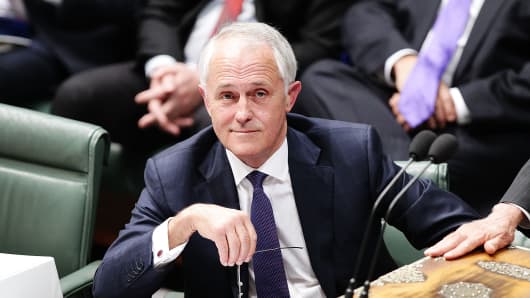Today, Australian Prime Minister Malcolm Turnbull and U.S. President Barack Obama will sit down at the White House to discuss a number of crucial issues from security to the economy. On the economy, they will focus on lagging global growth indicators and building support among other countries to implement policies that will catalyze growth.
For companies and consumers in Australia, the U.S., and throughout the world, greater growth is crucial. Increasing economic opportunity, and meeting the G20 goal set last year of at least 2 percent economic growth, is linked to rapid action on trade and investment. The first order of business should be implementing the Trans-Pacific Partnership (TPP) in 2016 and pressing ahead with other major agreements, such as the Trans-Atlantic Trade and Investment Partnership and the recently mooted EU-Australia free trade accord.
Today, economic opportunity is handicapped by low growth rates in many parts of the world. Last year's global growth rate was one of the slowest this century. Connected to the economic weakness is an even more dramatic decline in the rate of growth of global trade. In the 25 years before the 2008 global financial crisis, trade grew at about 6 percent a year. Since 2011, the growth rate has fallen to about 3 percent. This dry data translates to diminished opportunities and lower relative living standards for billions of people.
Reducing trade barriers will address the trade slowdown, and approving agreements such as the Trans-Pacific Partnership builds momentum for open trade and investment. The measure, agreed late last year, is the largest regional trade agreement in history. The 12 signatory countries — many represented in the G20 — collectively account for almost a third of global trade and about 40 percent of global gross domestic product. It has been estimated that the TPP would generate global income benefits of $223 billion a year within a decade, while also increasing annual world exports by $305 billion.
The North American Free Trade Agreement shows the potential positive impact of regional trade pacts. Trade flows between the U.S., Mexico and Canada escalated substantially under the more liberalized trading regime post NAFTA, supporting five million new jobs and wage gains in all three countries.
The release of the full TPP text reveals that the agreement can be a model for future trade agreements. In addition to slashing tens of thousands of tariffs applied to a wide range of products (18,000 tariffs are eliminated on American products alone ), the TPP addresses a number of critical issues in the modern global economy: financial services, telecom, e-commerce, state-owned enterprises, transparency, government procurement, intellectual property, labor, and the environment. It's not just about big business — it applies to small and medium enterprises too.
By approving TPP this year, the 12 market economies ringing the Pacific including the U.S., Australia, Japan, Canada and Mexico, will be setting a powerful example for other countries throughout the world. Approval will also help build momentum for the pending trade and investment agreement between the United States and the European Union.
Trade agreements like the TPP facilitate investment but the ultimate benefits are distributed to everyday consumers who secure access to more goods at lower prices. And the inflow of direct investment contributes to innovation and a long-term rise in living standards and creates jobs.
While the TPP can be a template for the future of cross-border agreements, this collaboration can take many different forms — such as the landmark China-Australia Free Trade Agreement. Importantly, the TPP door is open — more countries are free to join if they demonstrate a commitment to opening up to the global economy. A number of countries including Indonesia have already inquired about joining the TPP. China's appetite to conduct trade and investment partnerships is also enormously positive. As the engine of global growth, two-way trade and investment is vital to China's ability to continue growing. The mutual objective is to reduce trade barriers and strengthen investment protections across the board.
Now is the time for leaders to press for rapid progress on opening markets and strengthening the network of agreements that facilitate increased trade. Enacting measures like the TPP will stimulate the creation of high-paying jobs and contribute to stronger economic growth throughout the world. At a moment when both economic growth and the volume of trade is slowing, those are opportunities we cannot afford to miss.
Commentary by Sam Walsh, the chief executive of international mining and metals business Rio Tinto.
For more insight from CNBC contributors, follow @CNBCopinion on Twitter.




